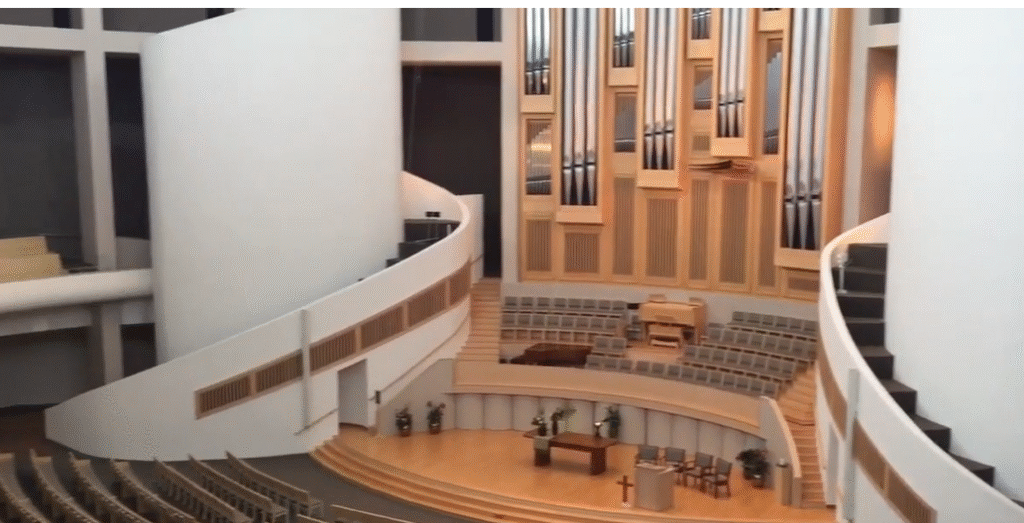The Community of Christ Temple in Independence, Missouri, is one of the few structures that successfully combines architecture and purpose. Standing as a testament to peace, spiritual unity, and inventiveness in sacred design, this towering structure is remarkably shaped like a silver spiral reaching into the sky. The temple’s distinctive design, created by the incredibly gifted architect Gyo Obata, has significantly enhanced Midwestern America’s architectural landscape and provides a spiritual hub that is on par with the magnificence of more well-known religious locations.
This temple, which was dedicated in 1994, came into being during a time when religious organizations started to rethink how space could be used for both worship and reconciliation. The spiral spire, a particularly inventive design, symbolizes a journey upward and human aspirations for divine connection. The ceiling, which is 195 feet high, pulls your heart and eyes upward in a gesture that is both literal and symbolic.
The engineering team made sure the structure would be not only aesthetically pleasing but also incredibly durable by working with the renowned A. Zahner Company, which is renowned for its mastery of metalwork. As a result, the sanctuary has endured through the ages, enduring both storms and the changing demands of contemporary places of worship.
Table: Community of Christ Temple – Key Information
| Feature | Detail |
|---|---|
| Name | Community of Christ Temple |
| Location | Independence, Missouri, USA |
| Architect | Gyo Obata (Hellmuth, Obata & Kassabaum – HOK) |
| Roof Engineers | A. Zahner Company |
| Year Dedicated | 1994 |
| Purpose | Peace, reconciliation, spiritual healing |
| Capacity | 1,600-seat sanctuary |
| Notable Feature | Spiral-shaped ceiling reaching 195 feet |
| Pipe Organ | 102-rank, 5,685 pipes by Casavant Frères |
| Official Website | Community of Christ Temple Tour |

Even though the sanctuary can hold 1,600 people, it feels incredibly personal. Both group rituals and private contemplation benefit greatly from this harmony between majesty and intimacy. Instead of echoing with fear, the room echoes with acceptance. Its graceful form and meditative silence often leave even nonreligious visitors feeling rejuvenated after strolling through its calm halls.
The grand pipe organ, which is a focal point of the temple and was built by Casavant Frères with 102 ranks and more than 5,600 pipes, produces a sound that is so rich and intricately layered that it goes beyond musical performance. The notes of the organ, rising like incense, seemed to fill every nook and cranny of the sanctuary with a sense of humanity during a recent interfaith peace concert. Its voice is felt as well as heard.
More tourists, religious scholars, and lovers of architecture have added the Community of Christ Temple to their lists of places to see during the last ten years. This temple speaks to future possibilities—where sacred spaces are inclusive, artistically daring, and profoundly connected to global concerns—in contrast to traditional cathedrals that were constructed to reflect historical power structures. For people who were previously alienated by strict religious formality, its purpose-driven design has greatly lowered barriers.
The temple offers young architects a motivational example of how values can be reflected in design. It’s a place that encourages reflection in addition to admiration. Under the spiraling ceiling, even children, who are frequently impatient in formal settings, react with an inquisitive silence. That quiet says a lot.
This temple has evolved into more than just a place of worship by utilizing deliberate symmetry, environmentally friendly engineering, and brilliant acoustics. It is a landmark in culture. Oprah Winfrey and other celebrities have discreetly stopped by for introspection, and the building is cited as an example of sacred inclusivity by theologians of all denominations.
Travelers are now looking for places that feed their minds and souls, which has led to a dynamic shift in spiritual tourism in recent years. This change is remarkably well-suited to the Community of Christ Temple. Its tenets are in line with society’s growing desire for places that bring people together rather than drive them apart and heal rather than condemn. Its gentle presence is especially consoling in the face of growing religious extremism and political division.
The temple has organized community services, educational retreats, and peace summits through strategic partnerships. In addition to improving civic life locally, these initiatives have increased the temple’s visibility abroad. Beyond the walls, its message reverberates, especially during musical performances that have been streamed and enthralled online audiences with their spiritual poignancy.
The temple has been compared to other famous religious buildings, such as the Sagrada Familia or the Bahá’í House of Worship, ever since it was dedicated. However, its refusal to exalt dogma is what distinguishes it. Rather, it honors communication, dignity, and optimism. Simply put, it invites visitors to feel rather than to believe.
While many churches closed during the pandemic, the temple continued to shine brightly. Its virtual tours and livestreamed meditations offered thousands of people worldwide comfort while in-person services were suspended. This flexibility proved not only faith but also foresight, establishing it as a very effective spiritual organization for modern-day seekers.
It is probable that both spiritual leaders and architectural historians will reexamine the Community of Christ Temple’s significance in the years to come. It serves as both a physical location and a representation of what religious organizations can develop into: compassionate, progressive, and profoundly human.

